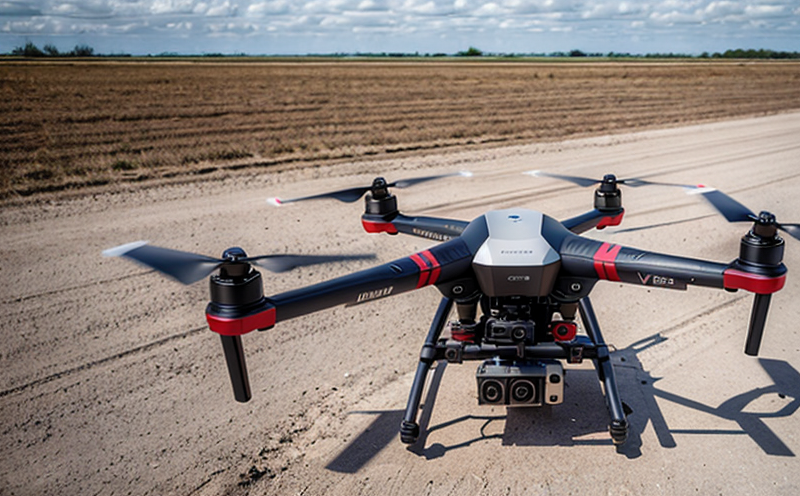ASTM F3389 UAV Ground Control Station Testing
The development and deployment of Unmanned Aerial Vehicle (UAV) ground control stations have revolutionized the way we operate drones in various sectors. These systems are critical for ensuring that UAVs perform reliably, safely, and efficiently under a wide range of conditions. ASTM F3389 provides a standardized approach to testing UAV ground control stations, which guarantees consistent quality and performance across different manufacturers.
ASTM F3389 defines the parameters and methods used for testing the functionality, reliability, and safety features of UAV ground control stations. Compliance with this standard ensures that these systems meet industry best practices and are suitable for deployment in real-world applications. This service is essential for quality managers, compliance officers, R&D engineers, and procurement personnel who need to ensure that their UAV ground control stations meet the required standards.
The ASTM F3389 test protocol includes a series of tests designed to evaluate various aspects of the system's performance. These include functional testing, environmental stress testing, electromagnetic compatibility (EMC) testing, and user interface evaluation. By adhering to these rigorous test protocols, manufacturers can demonstrate that their ground control stations are robust, reliable, and safe for use in diverse operational environments.
Testing a UAV ground control station under ASTM F3389 involves multiple steps. The first step is to ensure the system meets all specified requirements outlined in the standard. This includes verifying the hardware components, software interfaces, and communication protocols. Once these prerequisites are met, functional testing can begin. Functional tests assess whether the ground control station performs its intended functions correctly.
Environmental stress testing follows next. During this phase, the ground control station is subjected to various environmental conditions such as temperature extremes, humidity levels, and vibration exposure. This helps identify potential weaknesses or failures that might occur in real-world scenarios. After environmental stress testing, electromagnetic compatibility (EMC) testing ensures that the system does not interfere with other electronic devices and can function correctly within its intended electromagnetic environment.
User interface evaluation is crucial for assessing how intuitive and user-friendly the ground control station is. It involves evaluating various aspects like ease of use, ergonomics, and overall usability to ensure operators can efficiently manage UAV operations.
Scope and Methodology
The ASTM F3389 standard sets forth a comprehensive scope that covers all critical aspects of UAV ground control station testing. This includes evaluating the hardware components, software interfaces, communication protocols, functional performance, environmental resilience, electromagnetic compatibility, and user interface design.
| Test Category | Description |
|---|---|
| Functional Testing | Evaluation of the ground control station's ability to perform its intended functions. |
| Environmental Stress Testing | Subjecting the ground control station to various environmental conditions like temperature and humidity extremes, vibration exposure, etc. |
| Electromagnetic Compatibility (EMC) Testing | Determining if the system operates correctly within its intended electromagnetic environment without causing interference to other devices. |
| User Interface Evaluation | Evaluation of the ease of use, ergonomics, and overall usability of the ground control station. |
Benefits
The benefits of ASTM F3389 UAV Ground Control Station Testing are numerous. Firstly, compliance with this standard ensures that the ground control station meets industry best practices and is suitable for deployment in real-world applications. This leads to increased confidence among operators who know their equipment adheres to rigorous testing protocols.
- Enhanced reliability: By following ASTM F3389, manufacturers can identify potential issues early on, preventing costly failures during operation.
- Increased safety: The testing process ensures that the ground control station operates safely under all expected conditions, reducing risks associated with UAV operations.
- Improved efficiency: A well-tested system minimizes downtime and maintenance requirements, allowing for more efficient drone operations.
- Better regulatory compliance: Meeting ASTM F3389 standards helps companies comply with relevant regulations and certification requirements.
Use Cases and Application Examples
The ASTM F3389 UAV Ground Control Station Testing is applicable in numerous sectors where drones are used, including agriculture, logistics, public safety, and military operations. Below are some specific use cases that highlight the importance of this testing:
- Agriculture: Precision agriculture drones require reliable ground control stations to monitor crop health, apply pesticides, and collect data.
- Logistics: UAVs used in delivery services need robust ground control stations capable of handling various routes and weather conditions efficiently.
- PUBLIC SAFETY: Emergency response teams use drones for search and rescue operations, where a reliable ground control station is essential for critical missions.
- MILITARY: Military UAVs operate in challenging environments that demand high reliability and safety standards from their ground control stations.
| Use Case | Description |
|---|---|
| Precision Agriculture | Drone operations for crop monitoring, pesticide application, and data collection. |
| Logistics Delivery | Efficient UAV delivery services requiring reliable ground control stations. |
| Search & Rescue | Critical missions in emergency response scenarios where reliability is paramount. |
| Military Operations | UAVs operating under harsh conditions with high safety and performance requirements. |





